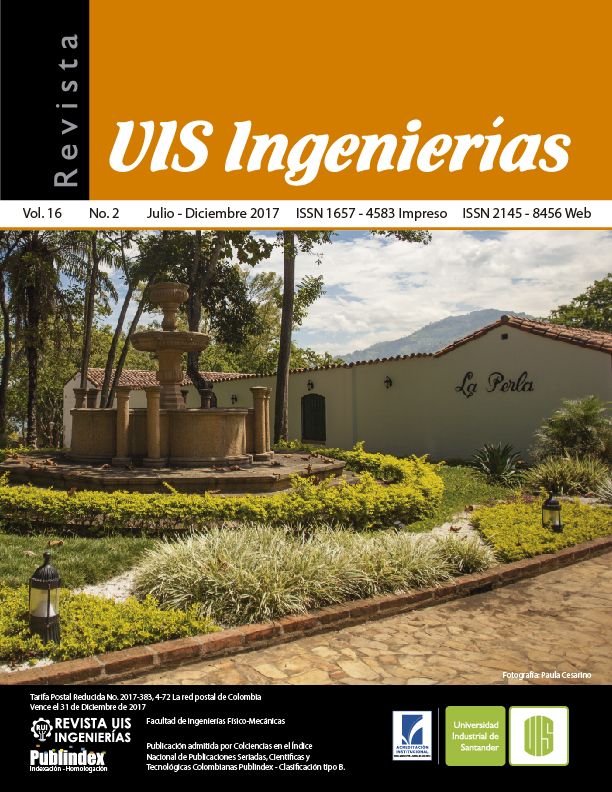Quantification of electrical energy savings in residential customers through demand management strategies
Published 2017-05-15
Keywords
- Demand management,
- demand management strategies,
- energy savings,
- load profile modeling
How to Cite
Abstract
Colombia faced from 2015 to 2016 one of most severe El Niño whether phenomenal in its history, being close to energy rationing. Demand management can help to reduce energy consumption under any scenario of energy availability, not only under emergencies. This article presents the quantification of potential savings in residential customers in Bogotá D.C., determined from the modeling of different demand management strategies. The results show energy reduction between 6 and 26% resorting to device substitution, 7 and 19% through energy consumption patterns adjustments, and between 17% and 45% as possible total energy savings. The results reveal as well that customers with low energy consumption can reach upto 45% savings, in contrast to customers with consumption energy greater than 150 kWh/month cannot reach energy saving above 20%.
Downloads
References
N. O’Connell, “Approaches for Accommodating Demand Response in Operational Problems and Assessing its Value,” Technical University of Denmark (DTU), Kgs. Lyngby, 2016.
M. H. Albadi and E. F. El-Saadany, “Demand response in electricity markets: An overview,” in 2007 IEEE Power Engineering Society General Meeting, PES, 2007.
J. Torriti, M. G. Hassan, and M. Leach, “Demand response experience in Europe: Policies, programmes and implementation,” Energy, vol. 35, no. 4, pp. 1575–1583, 2010.
M. H. Albadi and E. F. El-Saadany, “A summary of demand response in electricity markets,” Electric Power Systems Research, vol. 78, no. 11. pp. 1989–1996, 2008.
O. Corradi, H. Ochsenfeld, H. Madsen, and P. Pinson, “Controlling electricity consumption by forecasting its response to varying prices,” Power Syst. IEEE Trans., vol. 28, no. 1, pp. 421–429, 2013.
P. Thorsnes, J. Williams, and R. Lawson, “Consumer responses to time varying prices for electricity,” Energy Policy, vol. 49, pp. 552–561, 2012.
H. Allcott, “Rethinking real-time electricity pricing,” Resour. Energy Econ., vol. 33, no. 4, pp. 820–842, 2011.
O. A. Gonzalez and A. Pavas, “Evaluación del Potencial de Respuesta de la Demanda a partir de información de Perfiles de Consumo,” in V CIUREE, Congreso Internacional de Uso Racional de la Energía, 2016.
M. Doostizadeh and H. Ghasemi, “A day-ahead electricity pricing model based on smart metering and demand-side management,” Energy, vol. 46, no. 1, pp. 221–230, 2012.
S. Yousefi, M. P. Moghaddam, and V. J. Majd, “Optimal real time pricing in an agent-based retail market using a comprehensive demand response model,” Energy, vol. 36, no. 9, pp. 5716–5727, 2011.
N. Arghira, L. Hawarah, S. Ploix, and M. Jacomino, “Prediction of appliances energy use in smart homes,” Energy, vol. 48, no. 1, pp. 128–134, 2012.
J. H. Kim and A. Shcherbakova, “Common failures of demand response,” Energy, vol. 36, no. 2, pp. 873–880, 2011.
N. National Institute Standards and Technology, “NIST: Smartgrid.” [Online]. Available: http://www.nist.gov/smartgrid/. [Accessed: 23-Aug-2016].
ENERGY.GOV, “Estimating Appliance and Home Electronic Energy Use | Department of Energy.” [Online].Available:http://energy.gov/energysaver/estimating-appliance-and-home-electronic-energy-use. [Accessed: 23-Aug-2016].
L. L. Gracia and L. C. Torrecillas, “Guía sobre Consumo Energético de Aparatos Domésticos,” Zaragoza, 2009.
O. Laguerre, “Heat transfer and air flow in a domestic refrigerator,” Math. Model. Food Process. Mohammed M. Farid, vol. 474, pp. 445–474, 2010.
INSTITUTO COLOMBIANO DE NORMAS TÉCNICAS Y CERTIFICACIÓN, Eficiencia energética en artefactos refrigeradores, refrigeradores-congeladores y congeladores para uso doméstico NTC 5020. Bogotá DC. Colombia, 2014, p. 56.
H. Park, M. Ruellan, N. Martaj, R. Bennacer, and E. Monmasson, “Generic thermal model of electrical appliances in thermal building: Application to the case of a refrigerator,” Energy Build., vol. 62, pp. 335–342, 2013.
S. Martello and P. Toth, Knapsack problems: algorithms and computer implementations. John Wiley & Sons, Inc., 1990.
H. Kellerer, U. Pferschy, and D. Pisinger, Knapsack Problems, 1st ed. Berlin, Heidelberg: Springer-Verlag Berlin Heidelberg, 2004.
F. Sandoya, “El Problema de la Mochila, Complejidad, Cotas y Métodos de Búsqueda Eficientes,” vol. 12, no. 2, pp. 43–51, 2014.

